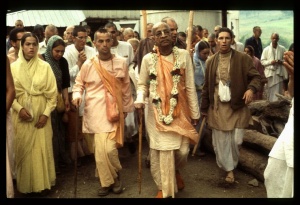CC Adi 17.83 (1975): Difference between revisions
(Vanibot #0027: CCMirror - Mirror CC's 1996 edition to form a basis for 1975) |
(Vanibot #0020: VersionCompareLinker - added a link to the Version Compare feature) |
||
| Line 2: | Line 2: | ||
<div style="float:left">'''[[Sri Caitanya-caritamrta (1975)|Śrī Caitanya-caritāmṛta (1975)]] - [[CC Adi (1975)|Ādi-līlā]] - [[CC Adi 17 (1975)|Chapter 17: The Pastimes of Lord Caitanya Mahāprabhu in His Youth]]'''</div> | <div style="float:left">'''[[Sri Caitanya-caritamrta (1975)|Śrī Caitanya-caritāmṛta (1975)]] - [[CC Adi (1975)|Ādi-līlā]] - [[CC Adi 17 (1975)|Chapter 17: The Pastimes of Lord Caitanya Mahāprabhu in His Youth]]'''</div> | ||
<div style="float:right">[[File:Go-previous.png|link=CC Adi 17.82 (1975)|Ādi-līlā 17.82]] '''[[CC Adi 17.82 (1975)|Ādi-līlā 17.82]] - [[CC Adi 17.84 (1975)|Ādi-līlā 17.84]]''' [[File:Go-next.png|link=CC Adi 17.84 (1975)|Ādi-līlā 17.84]]</div> | <div style="float:right">[[File:Go-previous.png|link=CC Adi 17.82 (1975)|Ādi-līlā 17.82]] '''[[CC Adi 17.82 (1975)|Ādi-līlā 17.82]] - [[CC Adi 17.84 (1975)|Ādi-līlā 17.84]]''' [[File:Go-next.png|link=CC Adi 17.84 (1975)|Ādi-līlā 17.84]]</div> | ||
{{CompareVersions|CC|Adi 17.83|CC 1975|CC 1996}} | |||
{{RandomImage}} | {{RandomImage}} | ||
==== TEXT 83 ==== | ==== TEXT 83 ==== | ||
<div class="verse"> | <div class="verse"> | ||
:rakta-pīta-varṇa, | :rakta-pīta-varṇa,--nāhi aṣṭhi-valkala | ||
:eka janera peṭa bhare khāile eka phala | :eka janera peṭa bhare khāile eka phala | ||
</div> | </div> | ||
| Line 18: | Line 17: | ||
<div class="synonyms"> | <div class="synonyms"> | ||
rakta-pīta-varṇa—the mangoes were red and yellow in color; nāhi—there was none; aṣṭhi—seed; valkala—or skin; eka—one; | rakta-pīta-varṇa—the mangoes were red and yellow in color; nāhi—there was none; aṣṭhi—seed; valkala—or skin; eka—one; janera—man's; peṭa—belly; bhare—filled up; khāile—if he would eat; eka—one; phala—fruit. | ||
</div> | </div> | ||
| Line 25: | Line 24: | ||
<div class="translation"> | <div class="translation"> | ||
The fruits were all red and yellow, with no seed inside and no skin outside, and eating one fruit would immediately fill a | The fruits were all red and yellow, with no seed inside and no skin outside, and eating one fruit would immediately fill a man's belly. | ||
</div> | </div> | ||
Latest revision as of 16:47, 26 January 2020
Śrī Caitanya-caritāmṛta (1975) - Ādi-līlā - Chapter 17: The Pastimes of Lord Caitanya Mahāprabhu in His Youth

His Divine Grace
A.C. Bhaktivedanta Swami Prabhupada
A.C. Bhaktivedanta Swami Prabhupada
TEXT 83
- rakta-pīta-varṇa,--nāhi aṣṭhi-valkala
- eka janera peṭa bhare khāile eka phala
SYNONYMS
rakta-pīta-varṇa—the mangoes were red and yellow in color; nāhi—there was none; aṣṭhi—seed; valkala—or skin; eka—one; janera—man's; peṭa—belly; bhare—filled up; khāile—if he would eat; eka—one; phala—fruit.
TRANSLATION
The fruits were all red and yellow, with no seed inside and no skin outside, and eating one fruit would immediately fill a man's belly.
PURPORT
In India a mango is considered best when it is red and yellow, its seed is very small, its skin is very thin, and it is so palatable that if a person eats one fruit he will be satisfied. The mango is considered the king of all fruits.